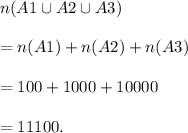
Mathematics, 29.11.2019 02:31 denisturcios18
Find the number of elements in a1 ∪ a2 ∪ a3 if there are 100 elements in a1, 1000 in a2, and 10,000 in a3 if
a) a1 ⊆ a2 and a2 ⊆ a3.
b) the sets are pairwise disjoint.
c) there are two elements common to each pair of sets and one element in all three sets.

Answers: 3


Other questions on the subject: Mathematics



Mathematics, 21.06.2019 22:10, layshjjbradshaw7250
What is the area of the original rectangle? 8 cm² 20 cm² 25 cm² 40 cm²
Answers: 1

Mathematics, 21.06.2019 22:30, mackenziepaige6525
The median for the given set of six ordered data values is 29.5 9 12 25 __ 41 48 what is the missing value?
Answers: 1
You know the right answer?
Find the number of elements in a1 ∪ a2 ∪ a3 if there are 100 elements in a1, 1000 in a2, and 10,000...
Questions in other subjects:


History, 10.10.2019 16:30

Biology, 10.10.2019 16:30






Mathematics, 10.10.2019 16:30






